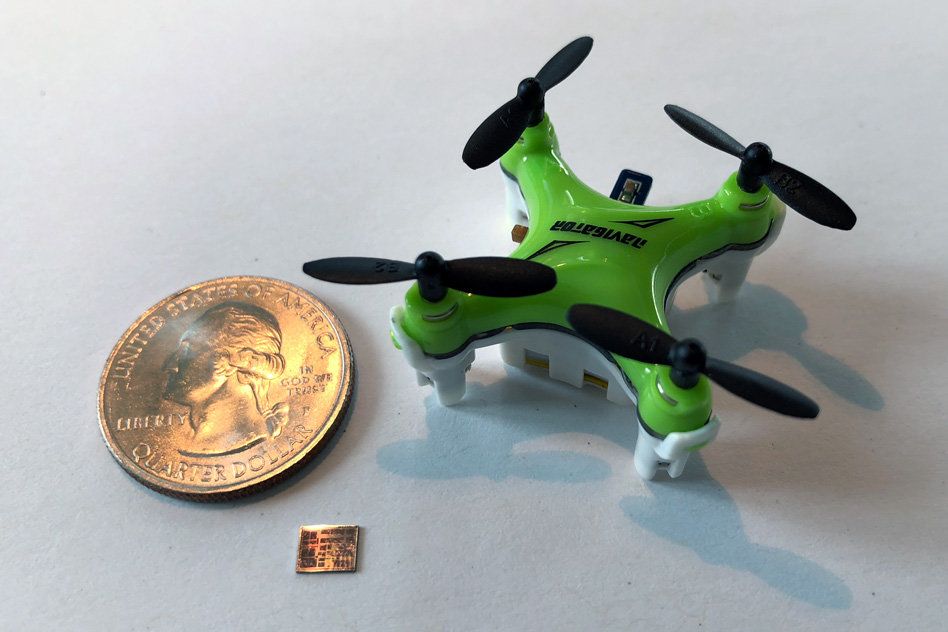This is the world’s smallest washing machine.
Get the latest international news and world events from around the world.
This boat runs on solar power
This solar-powered boat turns seawater into fresh water.

Chip upgrade helps miniature drones navigate
Researchers at MIT, who last year designed a tiny computer chip tailored to help honeybee-sized drones navigate, have now shrunk their chip design even further, in both size and power consumption.
The team, co-led by Vivienne Sze, associate professor in MIT’s Department of Electrical Engineering and Computer Science (EECS), and Sertac Karaman, the Class of 1948 Career Development Associate Professor of Aeronautics and Astronautics, built a fully customized chip from the ground up, with a focus on reducing power consumption and size while also increasing processing speed.
The new computer chip, named “Navion,” which they are presenting this week at the Symposia on VLSI Technology and Circuits, is just 20 square millimeters—about the size of a LEGO minifigure’s footprint—and consumes just 24 milliwatts of power, or about one-thousandth the energy required to power a lightbulb.
Thousands of Swedes are inserting microchips into themselves – here’s why
Often, different biohacking scenes reflect the different societies and cultures in which they develop. So, for example, European biohackers generally differ from their North American counterparts. North American groups are concerned with developing alternatives to the established healthcare practices. European groups, meanwhile, are more focused on finding ways of helping people in developing countries or engaging in artistic bio-projects.
Sweden’s deep relationship with digital technology helps explain why its biohacking scene is so unique.

Opinions on #ArtificialIntelligence are a dime a dozen, unless you’re hearing from one of the field’s pioneers
Join us at D60, DARPA’s 60th anniversary symposium, to learn from Ron Brachman about how #AI rose to prominence.
Artificial Intelligence has experienced waves of excitement before, but we have never seen the kind of worldwide enthusiasm that we see now, especially in the commercial sector, where AI has become the central mission of some of the world’s most powerful tech companies. DARPA is known for being the first supporter of AI research and panelists will highlight the impetus DARPA provided to the field’s most central technological areas, and give insights about where the field is going next.

Meet PowerDolphin the UNDERWATER drone!
You can now explore the ocean while sipping a pina colada on the beach!
Courtesy: PowerVision Europe

U.S. faces ‘unprecedented threat’ from China on tech takeover
I dont see it as a threat. Honestly, some of the US scientific community was getting really cocky, and really lazy, which is never a good combination. The US scientific community wanted to lock Crispr in a closet for 50 years. 30 years ago they could of gotten away with it. With China as it is now, they are forced to do research they would of rather hidden away.
China’s “Thousand Talents” program to tap into its citizens educated or employed in the U.S. is a key part of multi-pronged efforts to transfer, replicate and eventually overtake U.S. military and commercial technology, according to American intelligence officials.
The program, begun in 2008, is far from secret. But its unadvertised goal is “to facilitate the legal and illicit transfer of U.S. technology, intellectual property and know-how” to China, according to an unclassified analysis by the National Intelligence Council, the branch of U.S. intelligence that assesses long-term trends.
More from Bloomberg.com: U.S. Quits UN Human Rights Council, Saying It’s Anti-Israel.


This insane golden chamber contains water so pure it can dissolve metal, and is helping scientists detect dying stars
Super-Kamiokande (or “Super-K” as it’s sometimes referred to) is a neutrino detector. Neutrinos are sub-atomic particles which travel through space and pass through solid matter as though it were air.
Studying these particles is helping scientists detect dying stars and learn more about the universe. Business Insider spoke to three scientists about how the giant gold chamber works — and the dangers of conducting experiments inside it.